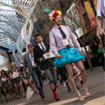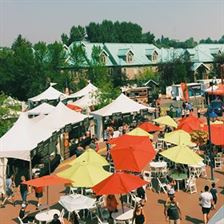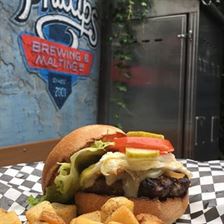 Canada Life Assurance Building on Stephen Avenue, AKA the Hollingsworth Building (retrieved from Canada’s Historic Places)
Canada Life Assurance Building on Stephen Avenue, AKA the Hollingsworth Building (retrieved from Canada’s Historic Places)
The fear that computer systems would not be able to handle the transition from 1999 to 2000 caused hysteria around the world. The dreaded Y2K panic had people fearing that computer systems and technology would fail, planes would fall from the sky, and the apocalypse would arrive. The hysteria was for naught. We survived the turn of the millennium. In fact, Calgary thrived.
The year 2000 was the inaugural year of the Calgary International Film Festival. It was held for six days and attended by 8,000 people. Today, the festival has expanded to 12 days and is attended by over 40,000. Gala events, meetings with filmmakers, special screenings, and films from more than 50 countries are on offer, with most of the action taking place right downtown at Eau Claire.



Also in 2000, a herd of fiberglass bovines took over the downtown core! A charitable art organization installed 125 life-size cow statues around the city with many located on Stephen Ave and in the downtown core. Called “Udderly Art,” these cows were originally white, then sold to businesses and individuals to paint and personalize. When the cattle were finally rounded up and sold at auction, they raised more than $1.2 million for 76 different charities. While downtown is no longer covered in cows, a few found a home in the +15 Walkway’s Udderly Art Legacy Pasture near the Centennial Parkade along 9th Ave SW from 5th to 6th Street.
 Udderly Art Map and Cows (Retrieved from www.udderlyart.com)
Udderly Art Map and Cows (Retrieved from www.udderlyart.com)
In 2002, Stephen Avenue was formally recognized as a National Historic Site of Canada. The Historic Sites and Monument Board of Canada’s minutes from 2001 describe the avenue as being an important part of the telling of “the processes of prairie urban development including orientation towards the railway” and the “rising importance of the retail sector in the Canadian economy” and of “the central role that such retail streets have played, and continue to play, in the Canadian urban experience.” The avenue was named after George Stephen, 1st Baron Mount Stephen, one of the greatest philanthropists of his time, financial architect behind CP Rail, and former President of the Bank of Montreal. Now known as the home to some of the city’s best restaurants, bars, and shopping, the pedestrian mall features historic façades and showcases Calgary’s unique blend of architecture.
In 2000, Bankers Hall West was completed at 888 3rd Street SW. Bankers Hall East had been completed in 1989, and the two became the tallest tallest twin buildings in Canada. The buildings have distinctive crowns, one silver and one gold, intended to represent the iconic cowboy hat that represents the city. Bankers Hall West incorporates the restored terra cotta façade of the historic 1912 Hollingsworth Building.
 Jamieson Place (Retrieved from Gibbs Gage Architecture)
Jamieson Place (Retrieved from Gibbs Gage Architecture)
In 2009, Jamieson Place was added to the downtown skyline. Located at 308-4th Avenue SW, the 38 story building was influenced by Frank Lloyd Wright’s prairie style. On the +15 level, the building is home to the largest indoor garden in Canada. Known as the Winter Garden, it features 20,000 plant varieties and the 26,000 ft2 space can be rented for private events. The building was named for Alice Jamieson, the first female judge of the British Empire and the second female magistrate in the Empire.
 Alice Jamieson (Source N/A)
Alice Jamieson (Source N/A)
While not one of the Famous Five immortalized in statue in Olympic Plaza, Jamieson’s involvement in a 1917 court case led to her competence as a judge challenged based on gender. This led to the Alberta Supreme Court deeming women persons, and thus able to preside over cases, and provided a catalyst for the eventual 1929 ‘Are Women Persons?’ case that the statue commemorates.
Related Posts
| Tweet |
|








